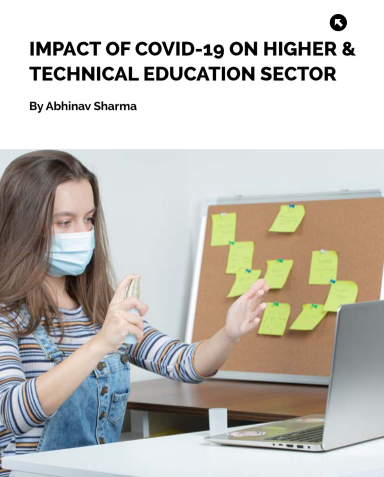
ABSTRACT
IMPACT OF COVID-19 ON HIGHER AND TECHNICAL EDUCATION SECTOR- Corona virus is an infectious disease, which was firstly identified in Wuhan, China. This disease has converted into a Pandemic, which has affected the Whole World. As of August 2020, approximately 24 million cases have been reported in the world. Symptoms include fever, cough, loss of smell, and shortness of breath. Even some cases in the country have been reported to be Asymptomatic. As a study, 40 percent of the cases have been reported with smell loss.
The virus spreads primarily through the nose and mouth. It is the most contagious disease found till date.
To prevent this pandemic, frequent hand washing, social distancing, and isolation are the most effective measures.
The COVID-19 pandemic has affected educational systems worldwide, leading to the near-total closures of schools, universities and colleges. Most governments around the world have temporarily closed educational institutions in an attempt to contain the spread of COVID-19.As of 7 June 2020, approximately 1.725 billion learners are currently affected due to school closures in response to the pandemic. According to UNICEF monitoring, 134 countries are currently implementing nationwide closures and 38 are implementing local closures, impacting about 98.5 percent of the world’s student population.
In the paper, we will be focusing on:
- Distance learning.
- Consequences of school closures.
- Recommendations for online learning.
INTRODUCTION:
Corona virus is an infectious disease, which was firstly identified in Wuhan, China. This disease has converted into a Pandemic, which has affected the Whole World. As of August 2020, approximately 24 million cases have been reported in the world. On 30th Jan. 2020, the first case of covid-19 was spotted in Kerala, India. Lakshadweep is the only place in India, with no official cases reported. Currently, India has the largest number of confirmed cases in Asia and is the third highest among countries of the world, after the US and Brazil.
Currently, India has cases above 34 lakhs. Symptoms include fever, cough, loss of smell, and shortness of breath. Even some cases in the country have been reported to be Asymptomatic. As a study, 40 percent of the cases have been reported with smell loss. The virus spreads primarily through the nose and mouth. It is the most contagious disease found till date. To prevent this pandemic, frequent hand washing, social distancing, and isolation are the most effective measures. The pandemic has affected every field, but its major impact can be seen in the Educational field.
The COVID-19 pandemic has affected educational systems worldwide
The COVID-19 pandemic has affected educational systems worldwide, leading to the near-total closures of schools, universities and colleges. Most governments around the world have temporarily closed educational institutions in an attempt to contain the spread of COVID-19.As of 7 June 2020, approximately 1.725 billion learners are currently affected due to school closures in response to the pandemic. According to UNICEF monitoring, 134 countries are currently implementing nationwide closures and 38 are implementing local closures, impacting about 98.5 percent of the world’s student population. School closures impact not only students, teachers, and families, but have far-reaching economic and societal consequences. School closures in response to the pandemic have shed light on various social and economic issues, including student debt, digital learning, food insecurity, and homelessness.
The impact was more severe for disadvantaged children and their families, causing interrupted learning, compromised nutrition, childcare problems, and consequent economic cost to families who could not work .In response to school closures, UNESCO recommended the use of distance learning programs and open educational applications and platforms that schools and teachers can use to reach learners remotely and limit the disruption of education.
Additionally, in some cases of earlier pandemic, the reopening of schools after a period of closure has resulted in increased infection rates.
As a result of the survey, 1.52 billion children are out of school due to closures, which is approximately 89 percent of the world’s population.
LITERATURE REVIEW:
| Country and Territory | No. of learners enrolled from Pre-primary to Upper-secondary education | No. of learners enrolled in Higher education | Additional Information |
| Austria | 1,278,170 | 430,370 | Schools closed. |
| Bulgaria | 974,469 | 249,937 | Both schools and universities are closed. |
| China | 233,169,621 | 42,266,464 | As the origin of the virus, China was the first country to mandate school closures. Following the Spring Festival holiday, China asked its nearly 200 million students to stay home and continue their education online. |
| Greece | 1,469,505 | 735,027 | Both schools and universities are closed. |
| India | 286,376,216 | 34,337,594 | On 16 March, India declared a countrywide lock-down of schools and colleges. On 19 March, the University Grants Commission asked universities to postpone exams till March 31. The board exams conducted by CBSE and ICSE boards were postponed until March 31 at first and then later until September.The Govt. had declared closure of educational institutes till August 31. |
OBJECTIVES:
The main objective of this paper is to survey the latest trends ongoing in the education field, after this pandemic.The ongoing pandemic has developed a focus on maximisation of online learning, a need for developing a solid education format which is even not affected by such diseases, and a need for value-based practical lessons.
CONSEQUENCES OF SCHOOL CLOSURE:
- STRAIN ON HEALTH
Due to prolonged sitting at computers, the children are facing health problems such as pain in eyesight, pain in neck, etc.
- UNEQUAL ACCESS TO TECHNOLOGY
- Lack of access to technology has prevented students in rural areas from attending regular classes.
- Lack of financial aid, due to parents’ limited income source, has left many students from attending online educational programmes.
- UNEQUAL ACCESS TO EDUCATIONAL RESOURCES
- Every instructor cannot access equal educational resources.
- Many of the instructors are not fully trained in online teaching.
- Even many instructors are not finding relevant educational resources on online platforms.
- Many instructors of Professional courses find it difficult to teach professional courses, without proper instruments at home, due to the sudden announcement of Lockdown.
- There are even issues with copyrights of certain books.
- Certain books are paid, even for online teaching.
- CHILDCARE
- Sudden school closure had put an extra burden on parents.
- The parents have to maintain a balance between their work from home and children’s education.
- Parents even have to take care of household chores too.
- FOOD INSECURITY
- Nutrition plays an important part in a child’s growth.
- Many children rely on mid-day meals in schools.
- Due to sudden closure, the food insecurity in such families becomes a burning issue for parents.
IMPACT ON FORMAL EDUCATION
- School closure had adversely affected today’s youth and children.
- Many educational lessons cannot be taught online.
- Schools are also hubs of social meeting and human interaction. Due to school closures, the children are deprived of this feature, which is essential for learning and development.
- Kindergarten children learn more frequently and easily, when exposed to classroom teaching, face-to-face.
- The interruption of formal education during this grade will result in a 67% loss of literacy ability in kindergarten children.
- IMPACT ON LEARNING ABILITIES
- The learning capacity of every child is different.
- In classroom teaching, the instructor faces the children face-to-face.
- It is easy for instructors to judge the learning ability of every child by viewing facial expressions, which becomes difficult in online teaching mode.
RECOMMENDATIONS FOR ONLINE LEARNING:
- CHOOSE RELEVANT TOOLS
- Choose such tools that are student-friendly.
- Decide to use high-technology and low-technology solutions based on the reliability of local power supplies, internet connectivity, and digital skills of teachers and students.
- This could range through integrated digital learning platforms, video lessons, MOOCs, to broadcasting through radios and TVs.
- PROTECT DATA PRIVACY
- Assess data privacy tools, while downloading educational videos.
- Ensure to use such platforms that do not violate students’ data privacy.
- PLAN STUDY SCHEDULE
- Organise discussions with school principals to examine the possible duration of school closures and decide whether the distance learning programme should focus on teaching new knowledge or enhance students’ knowledge of prior lessons.
- Plan the schedule depending on the situation of the affected zones, level of studies, needs of students, and availability of parents.
- Choose the appropriate learning methodologies based on the status of school closures and home-based quarantines.
- Avoid learning methodologies that require face-to-face communication.
- PROVIDE SUPPORT TO TEACHERS
- Organise brief training or orientation sessions for teachers and parents as well.
- Help teachers to prepare the basic settings such as solutions to the use of internet data if they are required to provide live streaming of lessons.
- DEVELOP DISTANCE LEARNING RULES
- Define the rules with parents and students on distance learning.
- Design formative questions, tests, or exercises to closely monitor students’ learning process.
- Try to use tools to support submission of students’ feedback and avoid overloading parents by requesting them to scan and send students’ feedback.
CONCLUSION:
I would like to conclude by stating that learners utilised this Pandemic period to enhance their education & authorities have utilised this period to develop more relevant education policies.
References:
- Coronavirus 2019 Wikipedia.
- Covid-19 pandemic in India Wikipedia.
- Article on impact of coronavirus on higher education by Times Higher Education forum.
Statement of Originality: I, being the author, take the whole responsibility for the originality of the paper. I, being the learner, have done this research from secondary sources only.
KEYWORDS:
Covid-19, Effects, Education, Online, Distance Learning, Recommendations.
About the Author :

Officiating HOD–Accommodation Operations
IHM Meerut
Abhinav Sharma
ABOUT BIZEMAG
ABOUT ADMYTED
